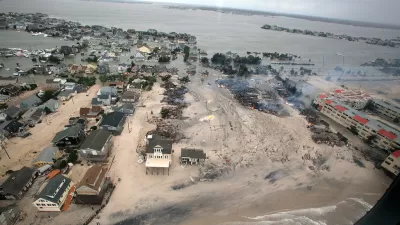After nearly a decade of ignoring warnings about the type of disaster witnessed this week, New York City and State officials may no longer be able to push off implementing drastic plans to safeguard the city from rising seas and super storms.
David W. Chen and Mireya Navarro consider the options for "major infrastructural changes" available to public officials as they confront the reality that what were once considered "100-year" storms may now occur fairly frequently.
"Gov. Andrew M. Cuomo said the state should consider a levee system or storm surge barriers and face up to the inadequacy of the existing protections," report Chen and Navarro. "The Cuomo administration plans talks with city and federal officials
about how to proceed. The task could be daunting, given fiscal
realities: storm surge barriers, the huge sea gates that some scientists
say would be the best protection against floods, could cost as much as
$10 billion."
"Under a proposal put forth by the Storm Surge Research Group
at Stony Brook University in 2004, large portions of the city could be
protected by three movable barriers installed at the upper end of the
East River near the Throgs Neck Bridge, under the Verrazano-Narrows
Bridge and at the mouth of the Arthur Kill between Staten Island and New
Jersey."
"Still," say Chen and Navarro, "some experts consider the barriers a last resort, and urge more modest changes, including subway floodgates."
Despite the renewed focus on the need to plan for disaster prevention, and not just response, "[w]hat scientists, who have devoted years of research to the subject, now
fear most is that, as soon as the cleanup from this storm is over, the
public will move on."
FULL STORY: For Years, Warnings That It Could Happen Here

Alabama: Trump Terminates Settlements for Black Communities Harmed By Raw Sewage
Trump deemed the landmark civil rights agreement “illegal DEI and environmental justice policy.”

Study: Maui’s Plan to Convert Vacation Rentals to Long-Term Housing Could Cause Nearly $1 Billion Economic Loss
The plan would reduce visitor accommodation by 25% resulting in 1,900 jobs lost.

Planetizen Federal Action Tracker
A weekly monitor of how Trump’s orders and actions are impacting planners and planning in America.

Wind Energy on the Rise Despite Federal Policy Reversal
The Trump administration is revoking federal support for renewable energy, but demand for new projects continues unabated.

Passengers Flock to Caltrain After Electrification
The new electric trains are running faster and more reliably, leading to strong ridership growth on the Bay Area rail system.

Texas Churches Rally Behind ‘Yes in God’s Back Yard’ Legislation
Religious leaders want the state to reduce zoning regulations to streamline leasing church-owned land to housing developers.
Urban Design for Planners 1: Software Tools
This six-course series explores essential urban design concepts using open source software and equips planners with the tools they need to participate fully in the urban design process.
Planning for Universal Design
Learn the tools for implementing Universal Design in planning regulations.
Caltrans
Smith Gee Studio
Institute for Housing and Urban Development Studies (IHS)
City of Grandview
Harvard GSD Executive Education
Toledo-Lucas County Plan Commissions
Salt Lake City
NYU Wagner Graduate School of Public Service



























